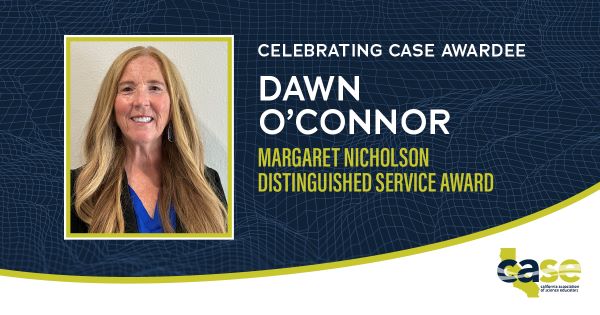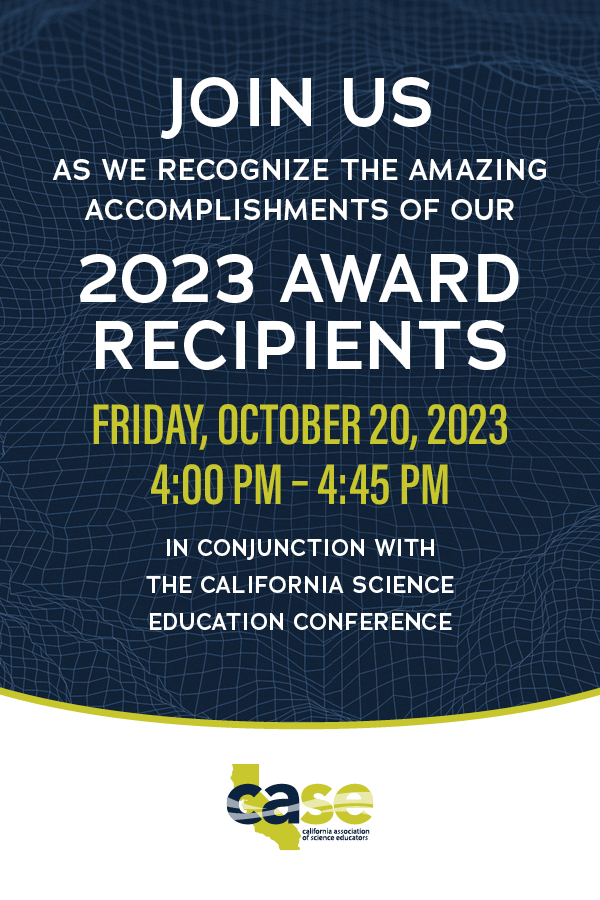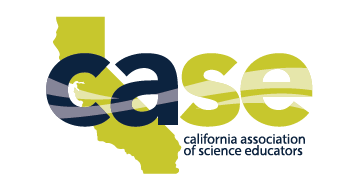
Margaret Nicholson Distinguished Service Award: Dawn O'Connor
Meet Dawn O'Connor
I am so honored to have received this award and grateful to my colleagues who wrote letters in support of my nomination. When I think about my colleagues that have previously received this award, I am humbled to be included amongst these fearless leaders who have stood up for science education over their career. These are my mentors, friends, and have been my role models! I feel that this award is a reflection of the incredible partners I have had to work alongside, the generosity of my family to give me space and time to take on new leadership, and the trust of others as I worked on new projects.

Tell us some of the most valuable lessons you’ve learned working with county and statewide organizations in California and how it has impacted your development personally and professionally.
One of the most valuable lessons I have learned during my journey when working with so many partners is the importance of collaboration across organizations. The quote by Mother Teresa “I can do things you cannot, you can do things I cannot; together we can do great things” has always inspired me to work alongside others motivated for similar goals. In education there are plenty of people who have resigned to the current conditions for learning as they became fatigued by the inherent bureaucracy within systems. Being an optimist by nature and doggedly persistent in the things I stand for, I was able to find my group of science educators willing to strive for a more equitable learning space and access for the students of California. In anticipation of the adoption of CA NGSS the various groups supporting science educators, policy alignment, and systemic changes partnered together to create a vision and plan to support the implementation of the CA NGSS. Prior to this endeavor a coherent approach to providing support and expanding services to rural and unserved areas, leveraging expertise, and learning from one another was not always happening. What started as a grassroot effort by a group of committed individuals has led to sustained and scaled science professional learning for the State, increased leadership opportunities and developed emerging leaders, and established relationships. Building strong collaborative relationships can help individuals achieve their goals and serve their constituents better. As science leaders we have a network now to lean into, engage in messy thinking, seek guidance in areas where we lack expertise, and continue to learn from one another. Another lesson learned is as leaders we need to be systems thinkers. Making changes in classrooms, school sites, districts, and policy takes time and requires deep understanding of change and systems. As my tenure as both a Director for the California Science Project (East Bay) and County Office of Education (Alameda) I recognize that I am always an external partner when working with educators. Each of these districts have their own local context and in order to have science be a priority or even on their radar it is important to understand their goals for learning and their priorities.
Helping leaders see “their system” as it currently exists, develop a vision for science teaching and learning, and a map to their goals creates a coherent implementation plan. This type of work is slow, messy at times, and impactful. There is often an expectation for rapid transformational change that is unrealistic and as leaders we need to develop models for others to follow. Working with other leaders across the state we have been able to develop professional development for school leaders, implementation tools, and partnerships to do this work. On my own it would have been difficult to have a broader impact and to grow my own knowledge. Through funding from the NGSS Collaborative I was able to work with leaders Kathy Diranna from K12 Alliance and Vanessa Lujan from Bay Sci (Lawrence Hall of Science) to think deeply about the needs of principals and school leaders.
Having a model for leadership development matters. As we the various groups leading for science (e.g. CASE, CA Science Project, K12 Alliance) came together for multiple initiatives it became evident that those identified were often the same leaders and that leadership didn’t always reflect the diversity of our state or emerging leaders. As leaders it is important to know when to step up and when to step back if we are to create space for new leadership to develop, grow, and eventually lead in new spaces. I loved the model created by the NGSS Collaborative as we grew over the years. Experienced writers and leaders became mentors to new writing teams. These new teams could lean into their mentor, use the scaffolding provided from prior years, and leverage their own experiences to develop new modules. As I have grown as a leader, I began to recognize we often began to identify and bring emerging leaders into these “inner circles” when we were looking for our own replacements. I have come to see the importance of early leadership. Opening spaces for new leaders, teacher leaders, and for those who haven’t yet seen their own leadership capacity. Actively inviting, introducing, and encouraging these emerging leaders to share their voice and experiences creates the space for others.
What do you consider to be the biggest accomplishment of your career so far and why?
The past 12 years I have been serving as the Director and Co-PI for the Science Partnership of the East Bay. This unique partnership between the Alameda County Office of Education and CSU East Bay has made a commitment to serve school districts within the San Francisco Bay Area who are committed to transforming science education within their district. As a partnership we have a shared leadership approach composed of faculty at CSU East Bay and the Science Leader at the Alameda County Office of Education. As a leadership team we have written and received numerous grants to research professional learning models that can result in transformative changes within classrooms, administrators, and school implementation planning teams. The Science Partnership is unique in that we are composed of researchers, scientists, pedagogical experts, and teacher leaders working as a professional development team and all committed to the research goals. As a partnership we are committed to honoring the expertise of teachers, have a belief that all students deserve access to science learning that is relevant and respects the contributions of all learners, teachers need time to try new pedagogical approaches and do that best in a collaborative setting like lesson study, and reform happens at the system level. As an educator I have many experiences that mattered and made me feel proud to be an educator. I loved my years teaching middle school science and seeing students have that “aha” moment, mentoring students who engaged in long term science investigations that led them to the County and State, coaching runners to develop a love for the run, and working as a BTSA mentor with early career STEM educators. Why I would say the past 12 years mattered the most is that this opportunity afforded me the chance to lead for change at scale, uplift teacher leaders' voices, create opportunities for new and varied leadership, and contribute to new understandings around implementation and reform. Our approach involves working with district teams over a 3–7-year time frame to implement a professional learning model. This model includes deep science content and pedagogical knowledge development and lesson study for teachers, PD for administrators, and support for a district implementation team that include district office leaders, school site administrators, and teacher leaders. That team is responsible for developing a science implementation plan. Getting to be part of this work has grown me as a leader as I have had to become a more skilled listener and facilitator, navigate changing educational policies and initiatives that can distract school leaders, and be a constant champion for deeper meaningful learning for all. I feel that as a team we have learned much from these partnerships. We have been able to publish papers for researchers and practitioners, create toolkits, built relationships, and created leadership opportunities.
What would you recommend for others to do to find encouragement and keep growing in their career?
Take chances, don’t wait till you think you have every skill required or assume others have the ideas, acknowledge the challenges that the educational system presents but don’t get stuck because of these challenges, seek the company of others who share your passion, join a group through organizations such as your County Office of Education, CASE, CA Science Project, and keep being curious! As you grow your leadership don’t forget that the most important person for our students is our teachers! So, when you work with them remember that they are the daily practitioner of teaching, they have a ton of expertise, and that they bring the best they have to their classroom daily. Always have an asset view of educators.
Tell us, what is next for you?
Well, I have just retired from my role at the County Office of Education and the Ca Science Project. I plan on traveling more and spending time exploring new places on my bike and paddle board. I will continue to partner with the Science Partnership on papers and tools from our research. I have been working on various colleagues' projects as an advisor and it has been so interesting to learn about others' research. I am giving myself a year to see what retirement will look like!
Quick Links
Exhibit Partner Package
Opening Soon
Join us at the 2025 California Science Education Conference, the premier event for science educators across California! This gathering is your chance to showcase your products, engage with educators, and maximize your impact through our exclusive Partner Program.


